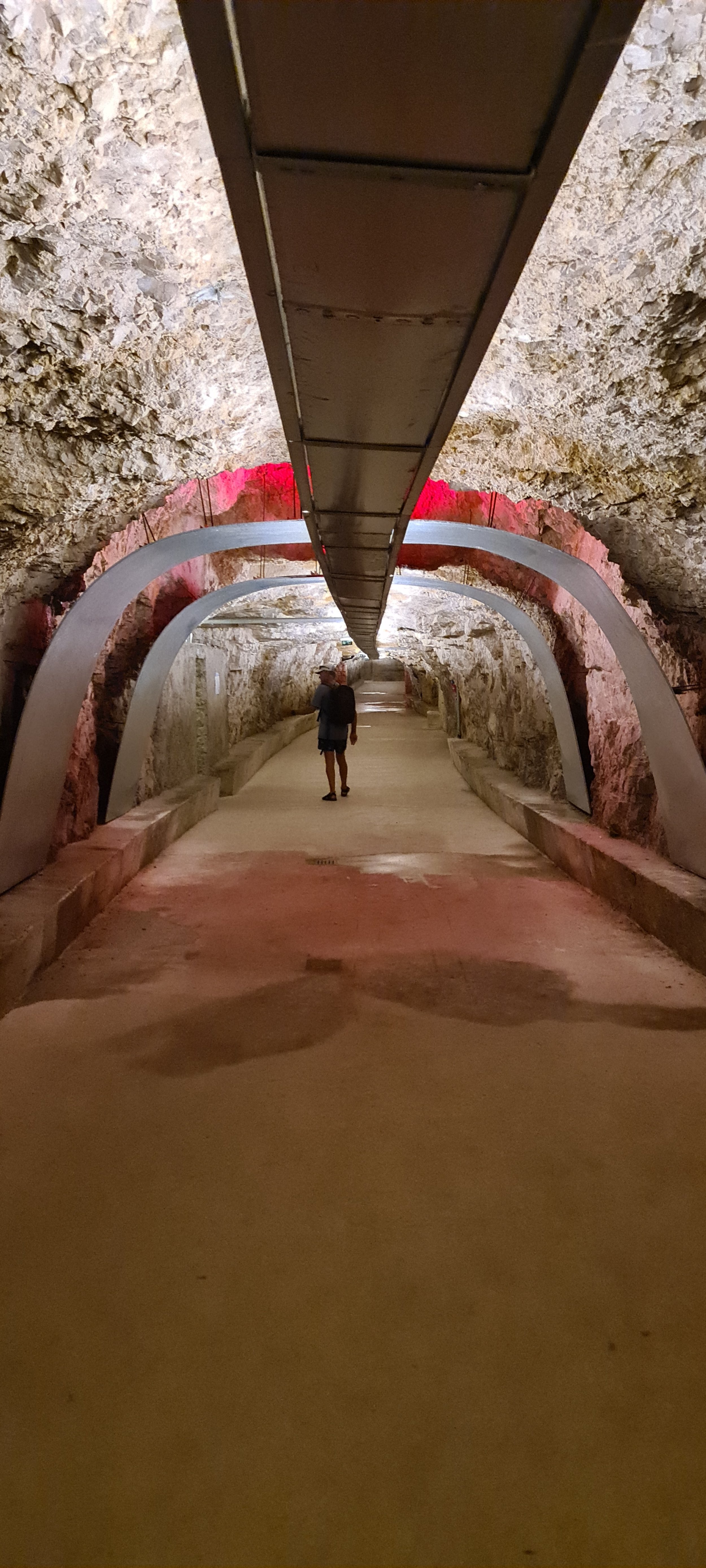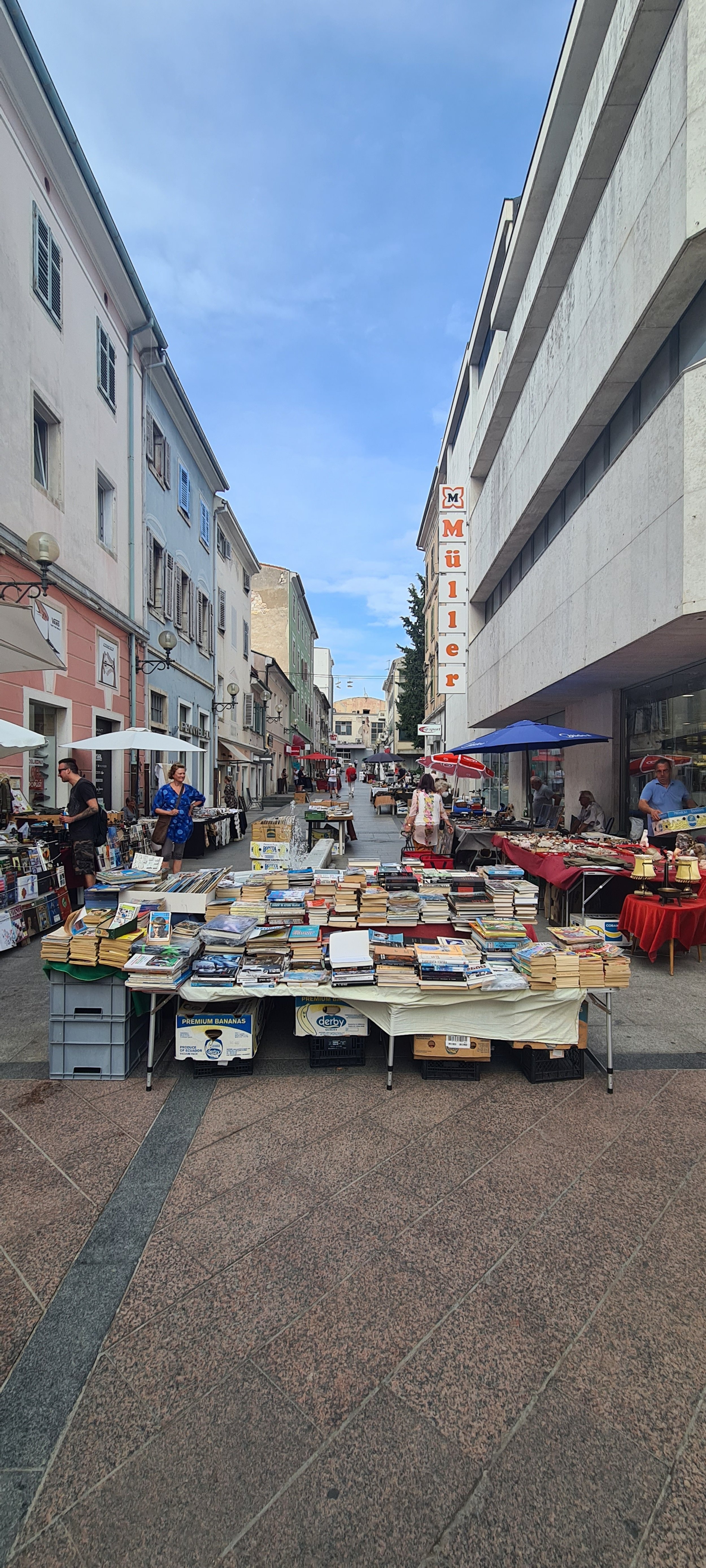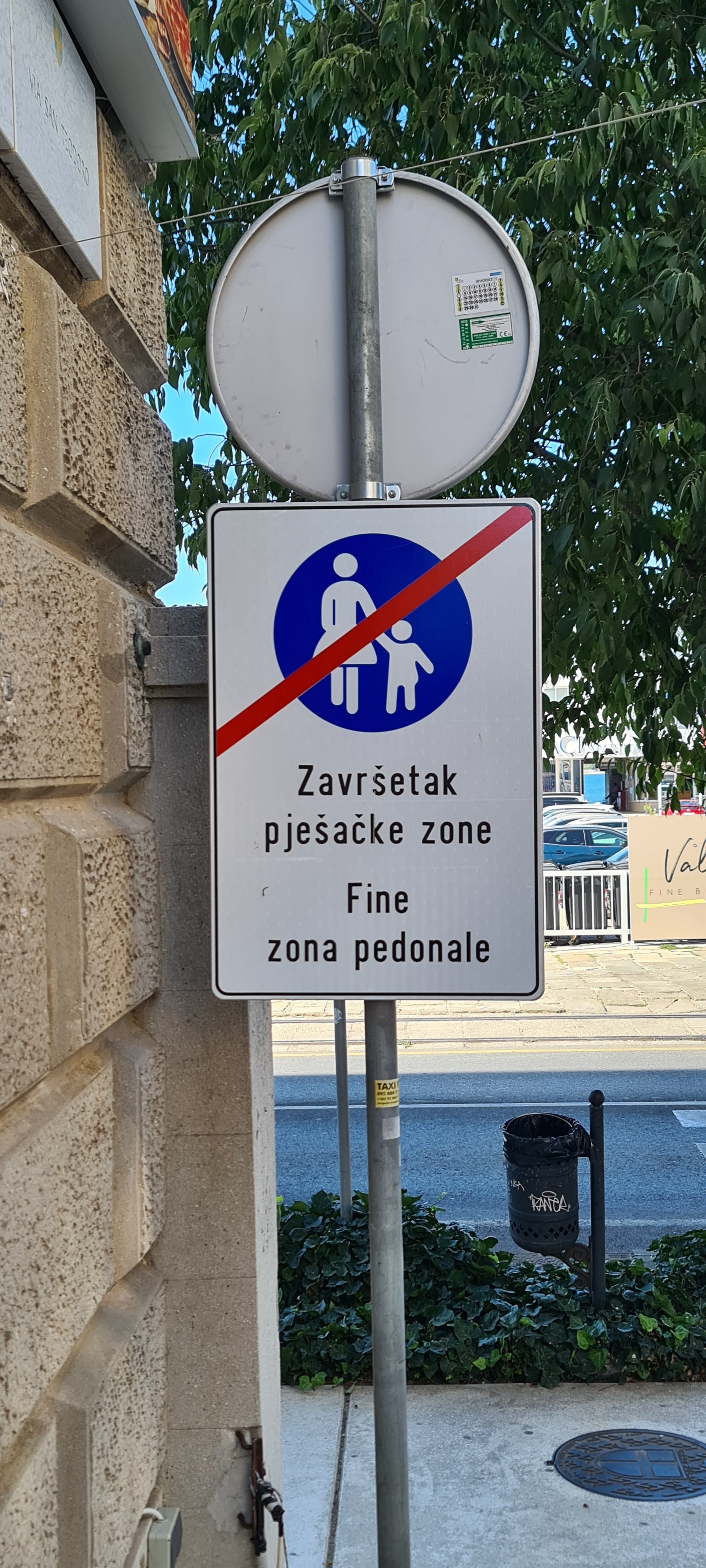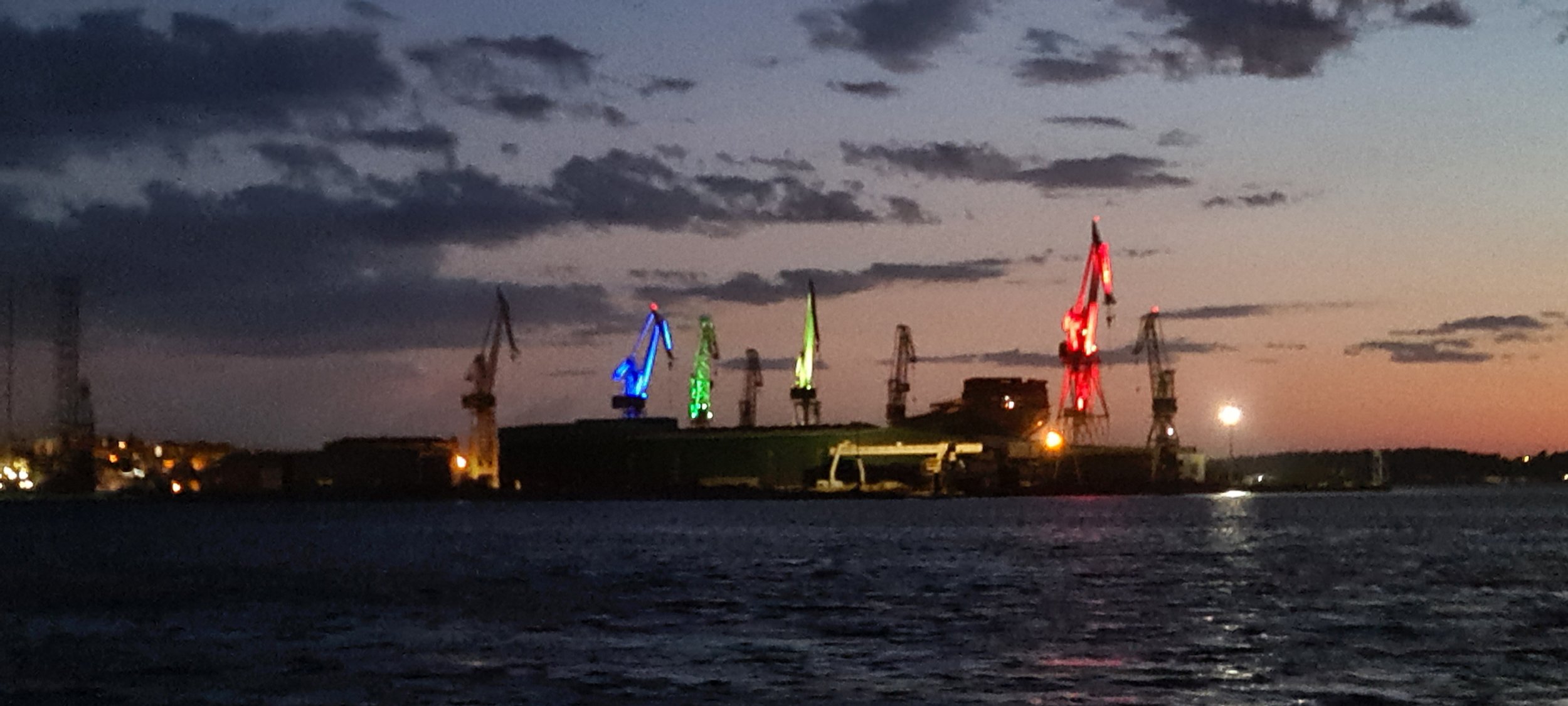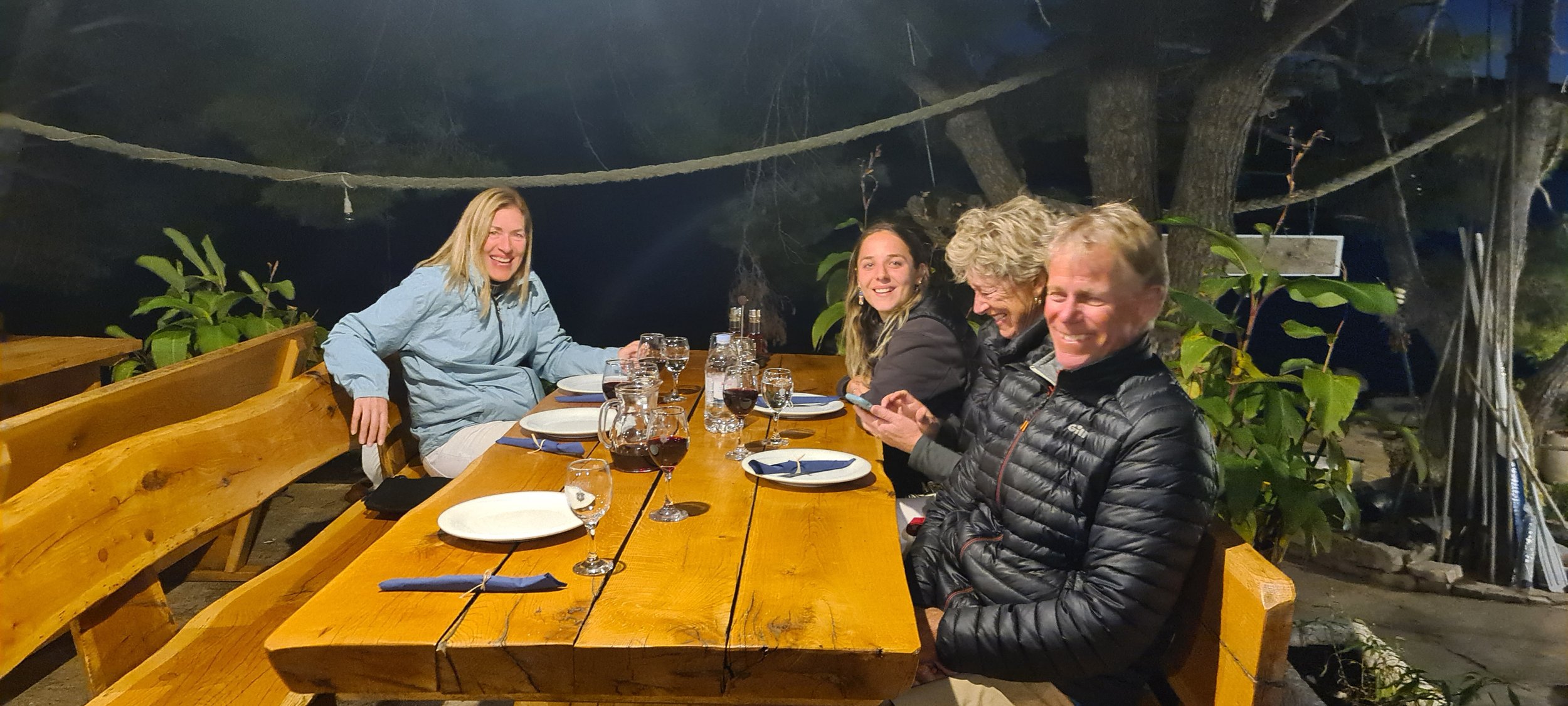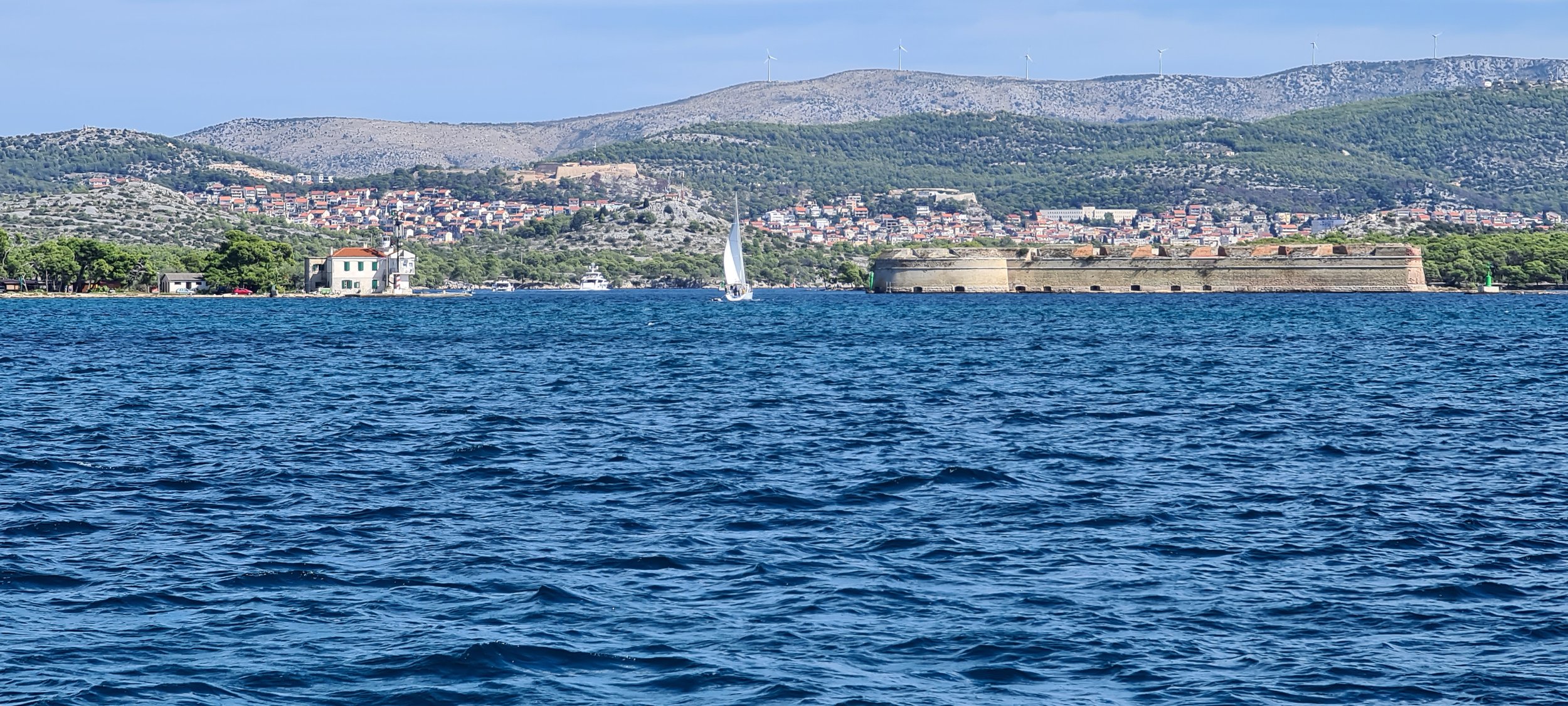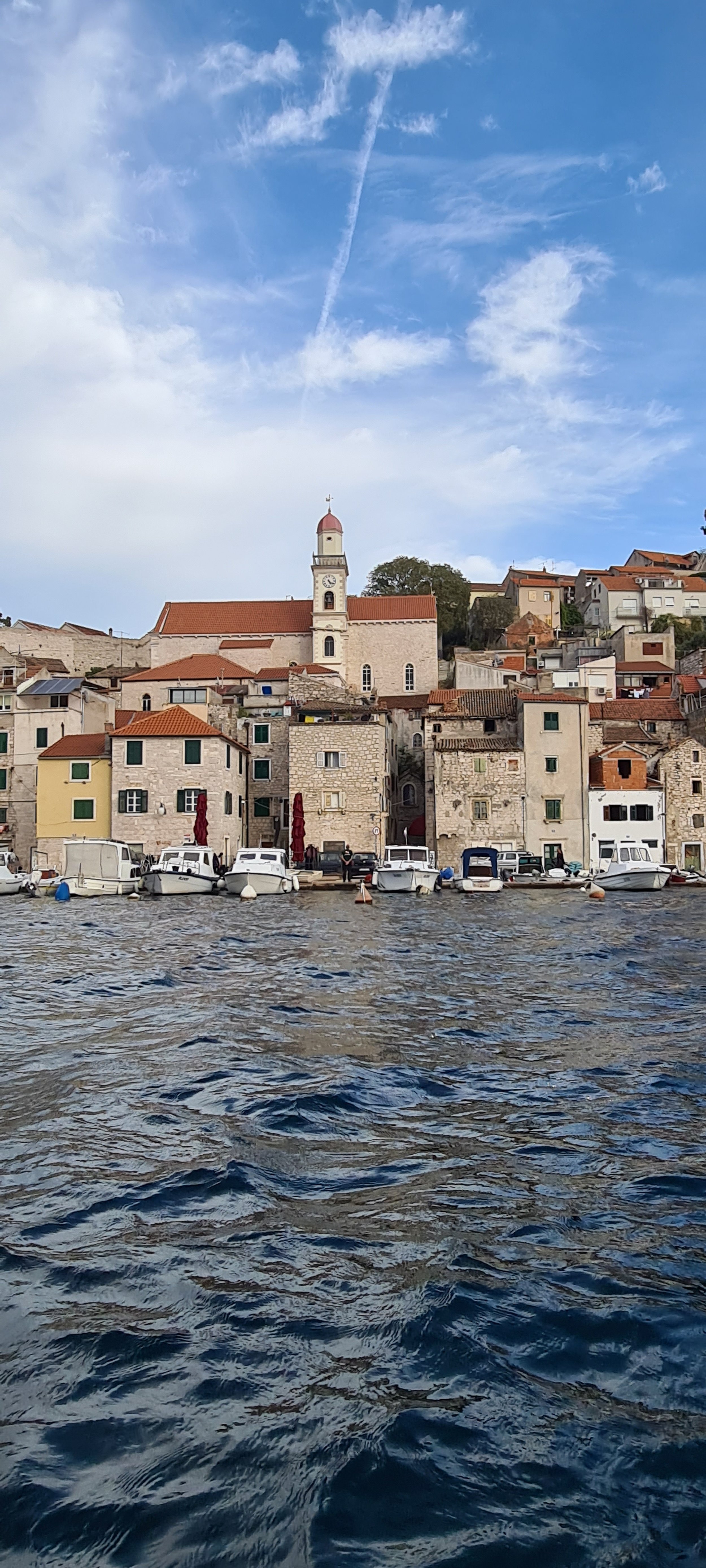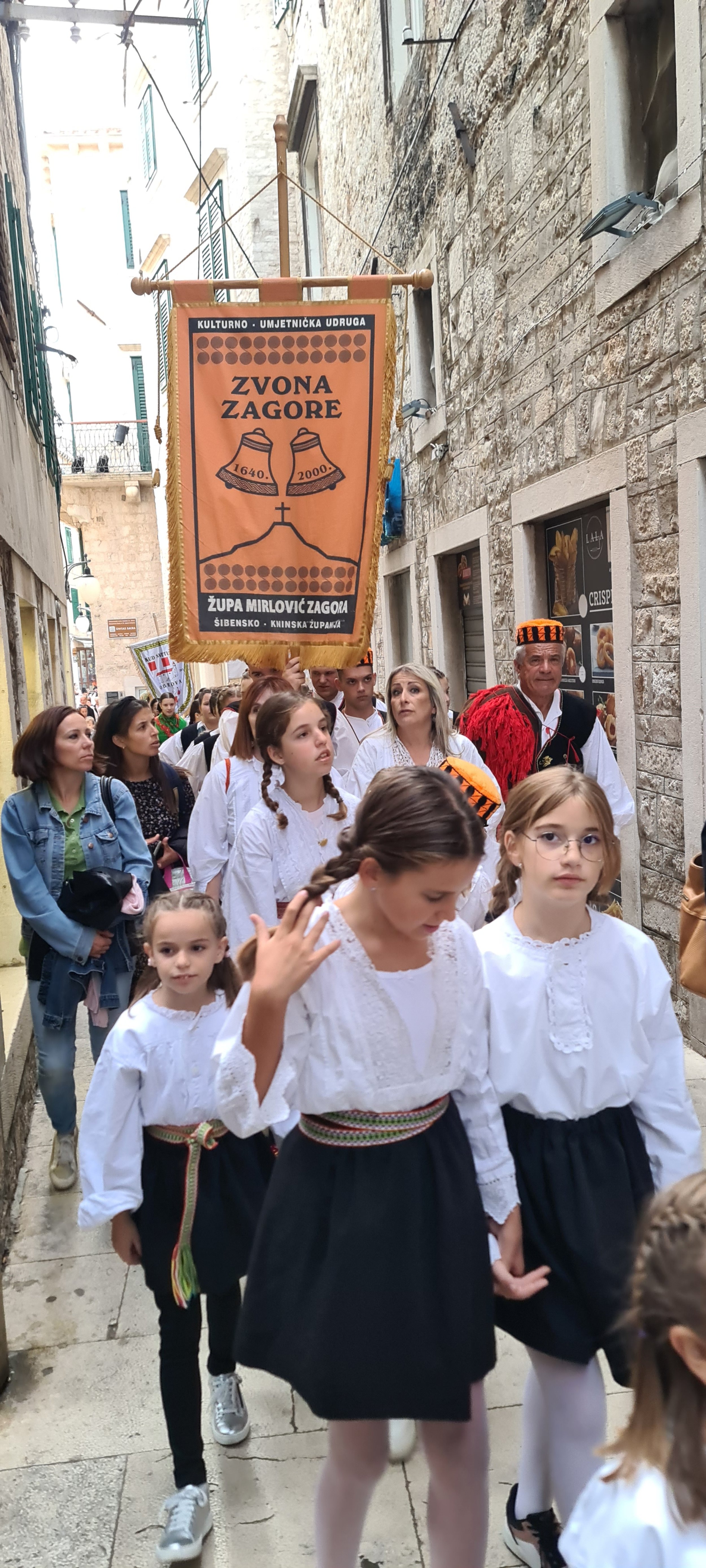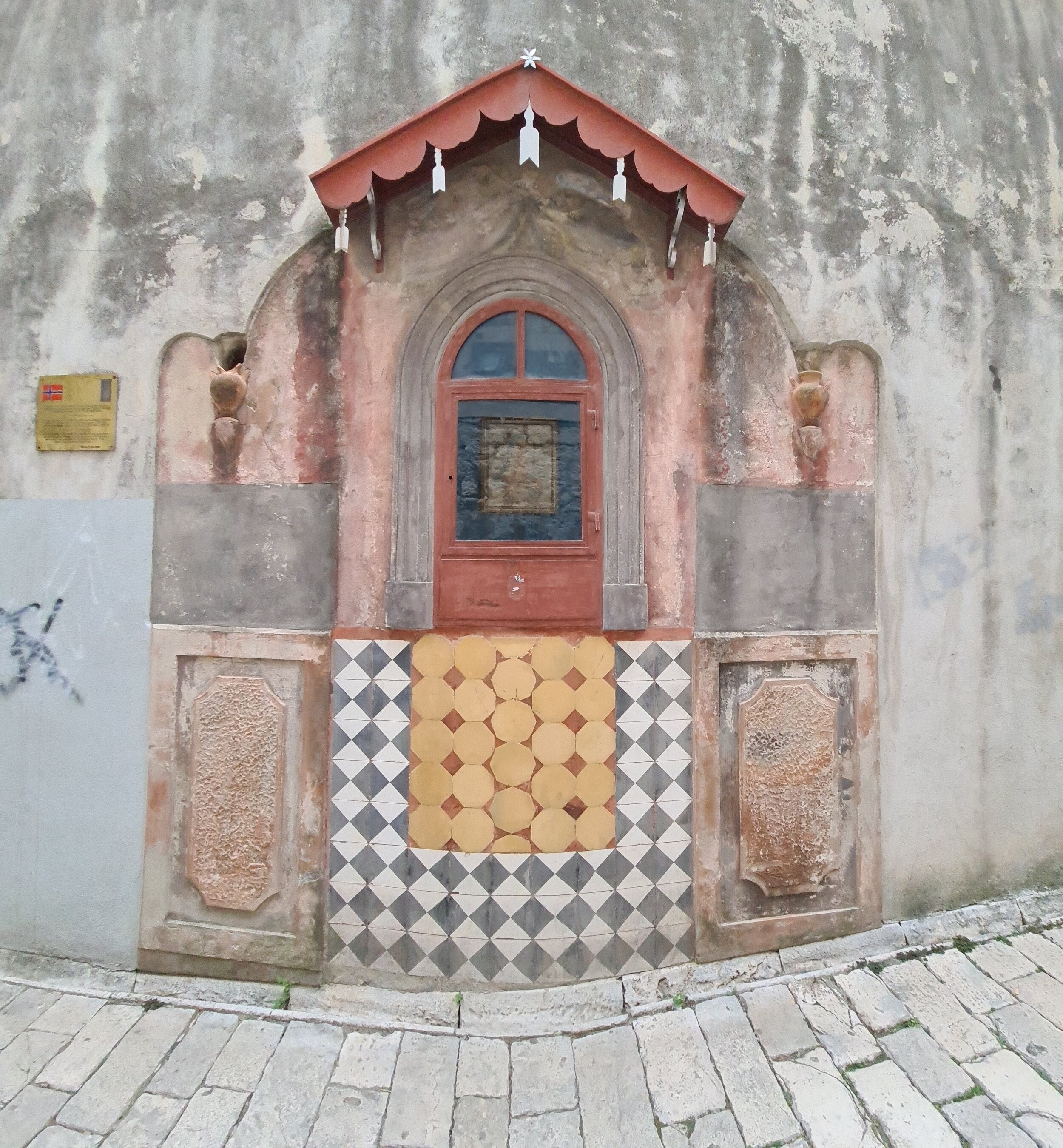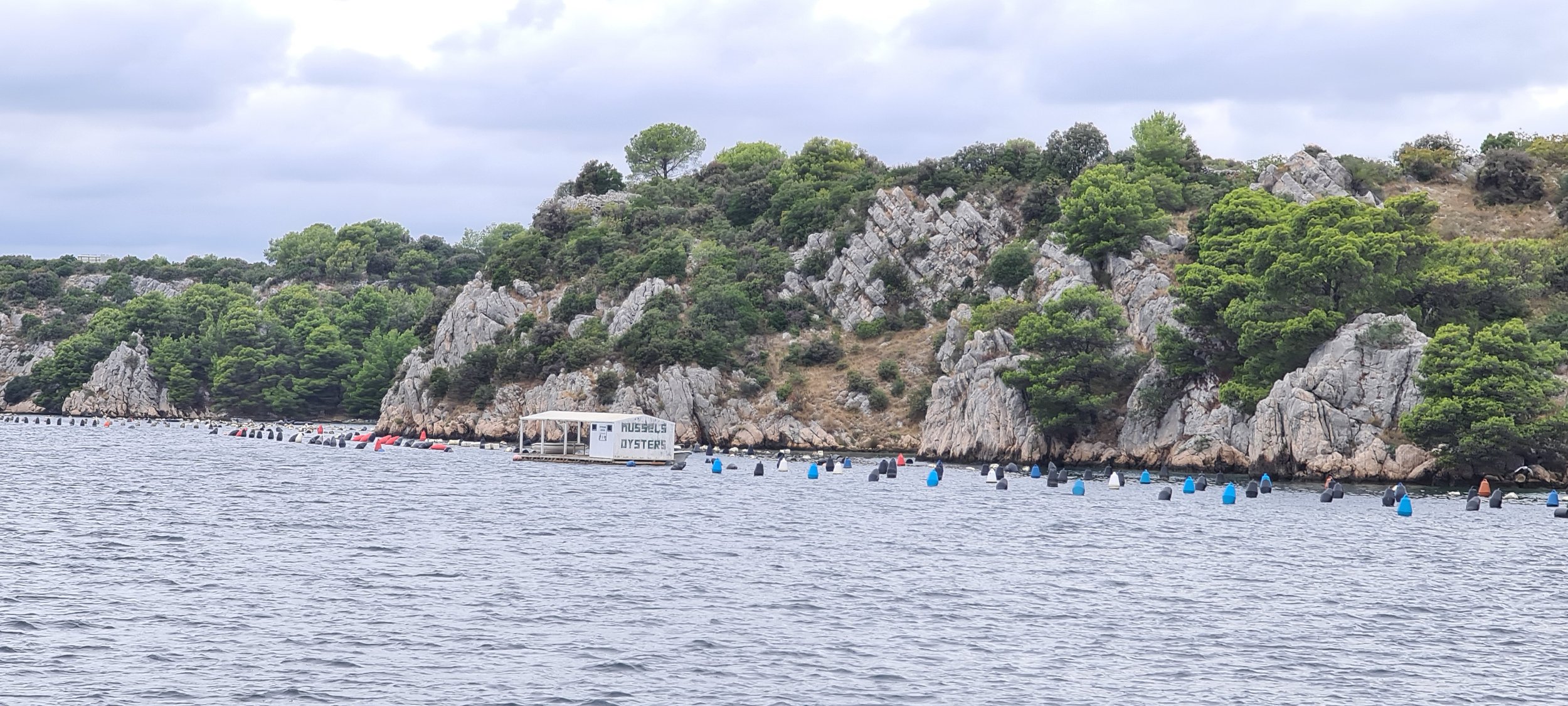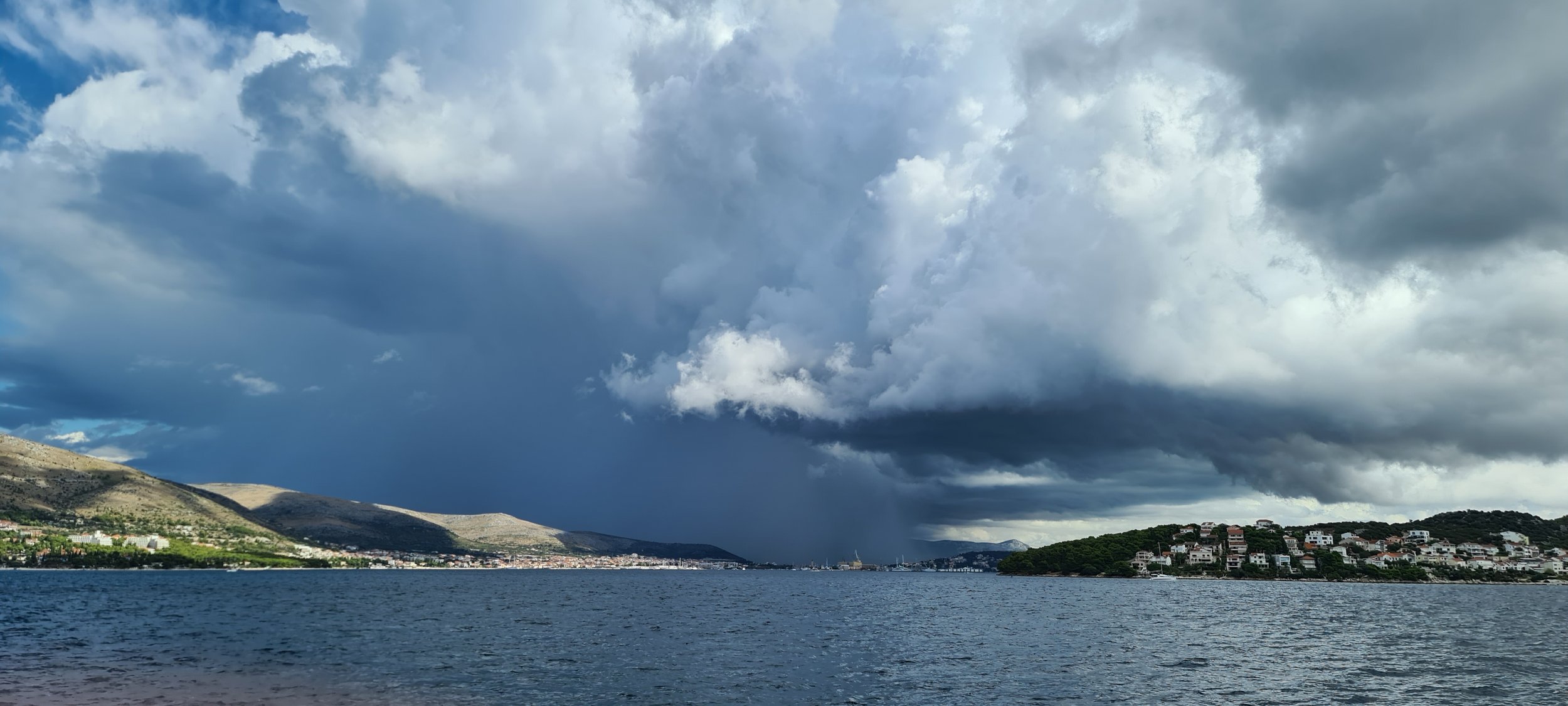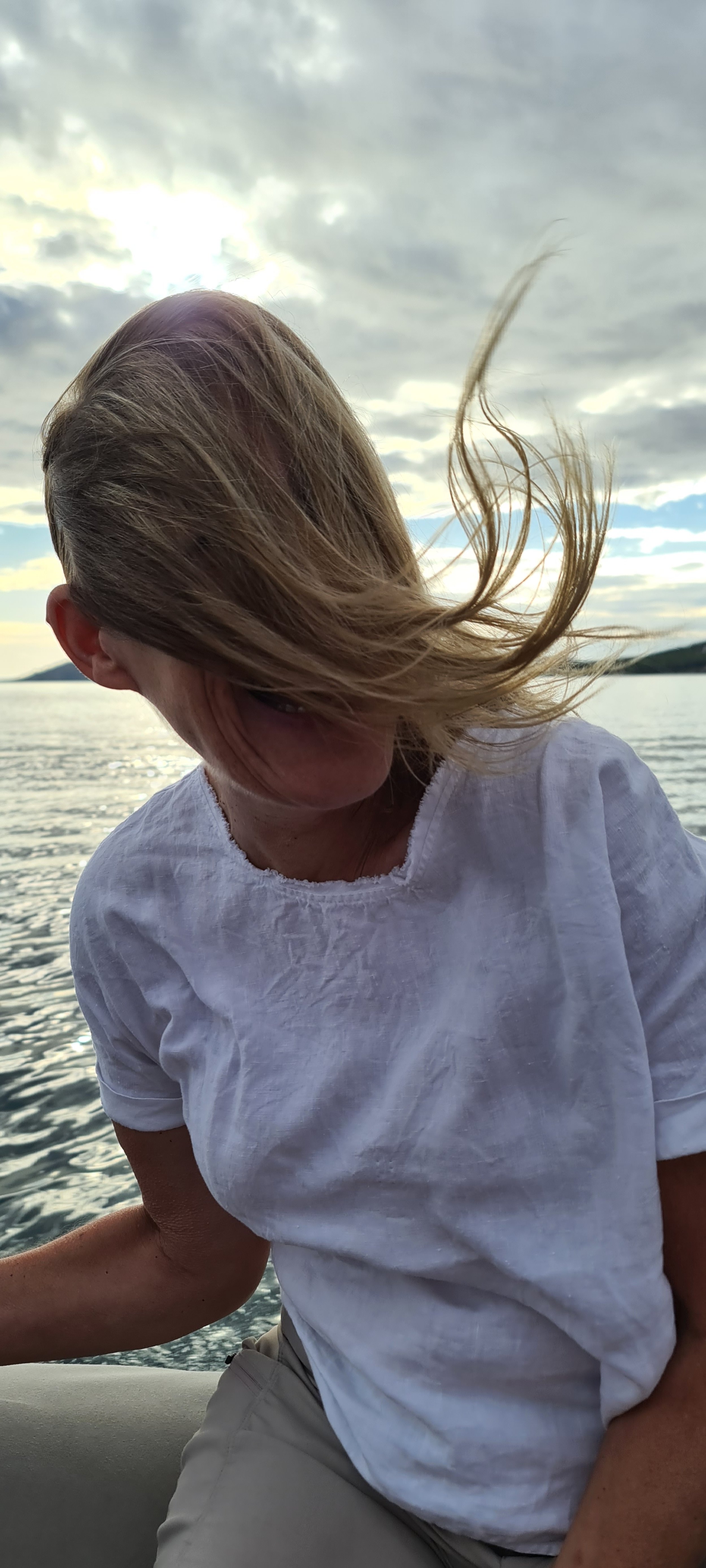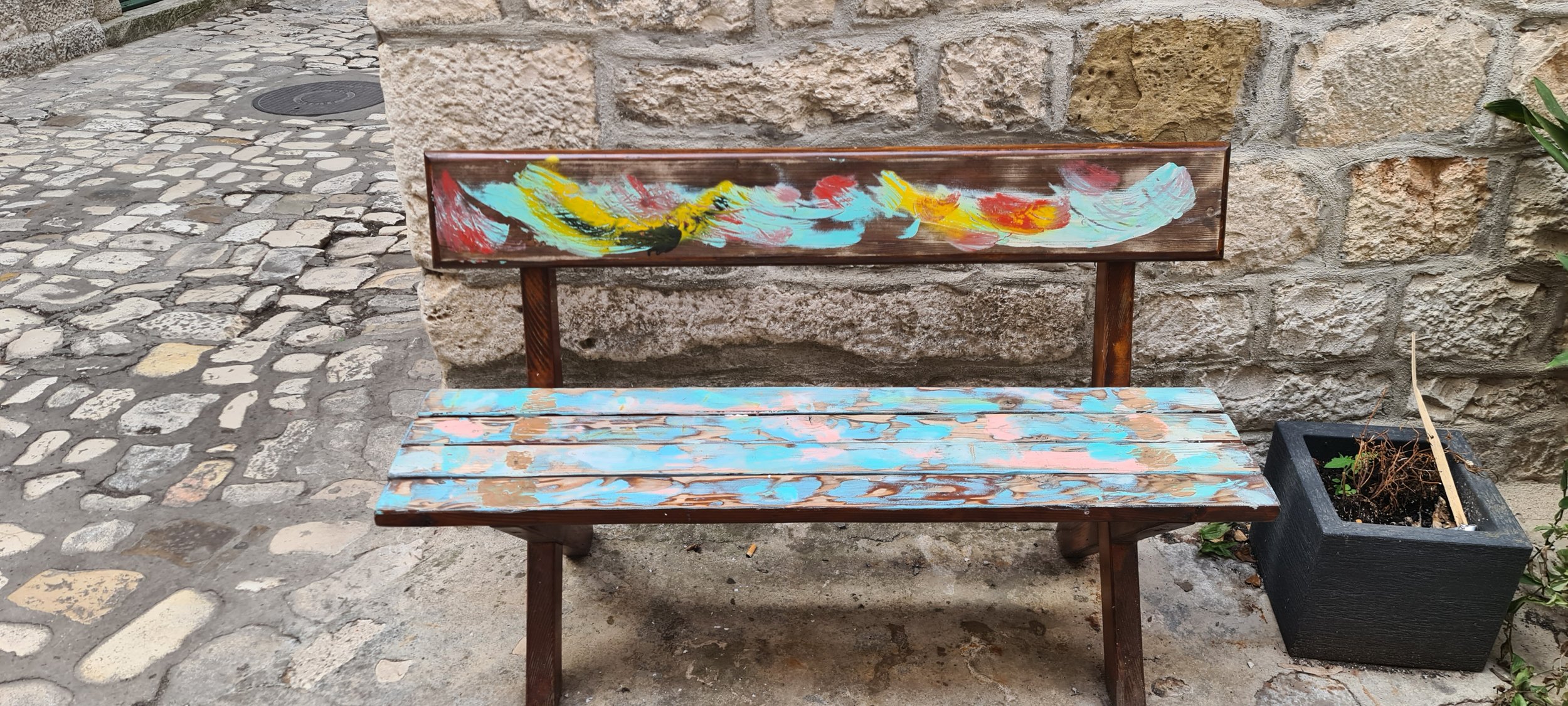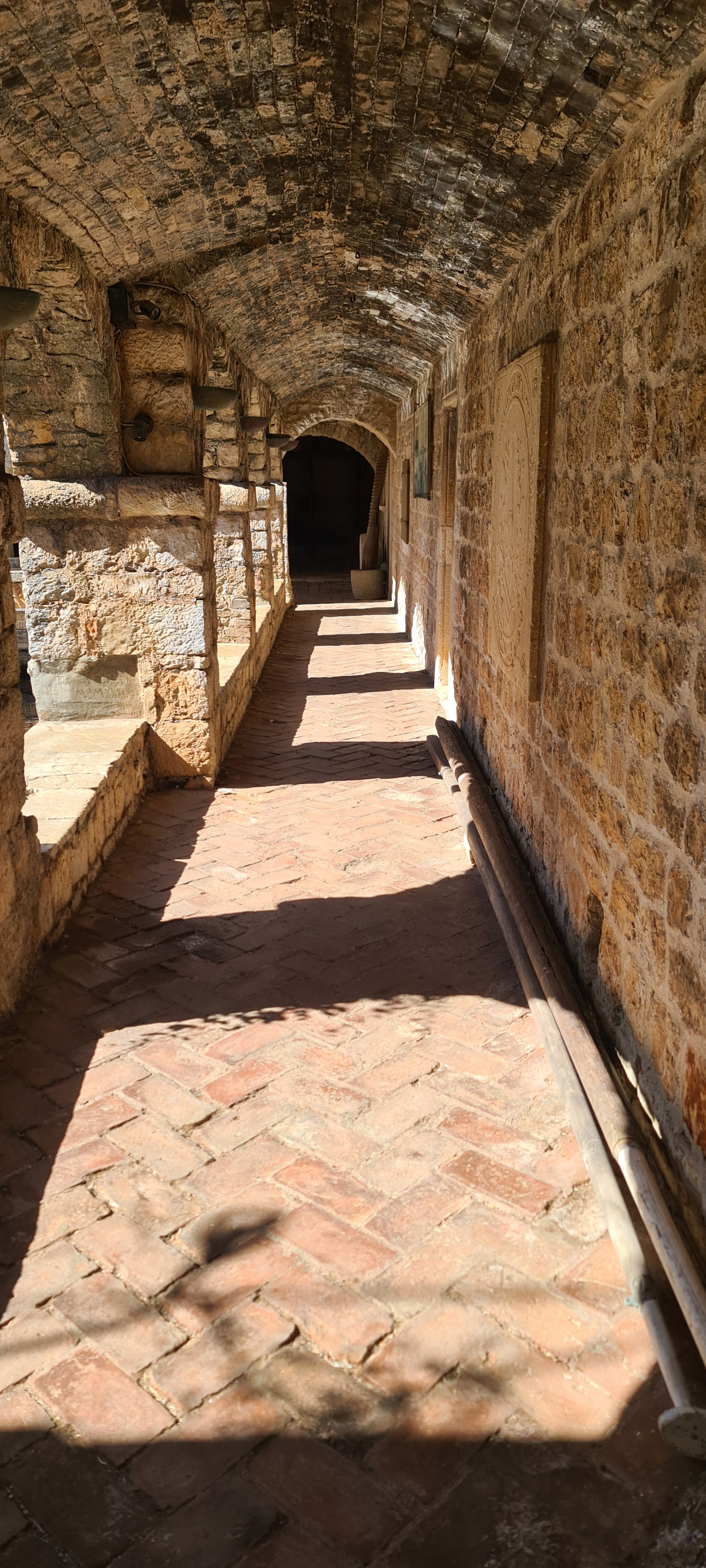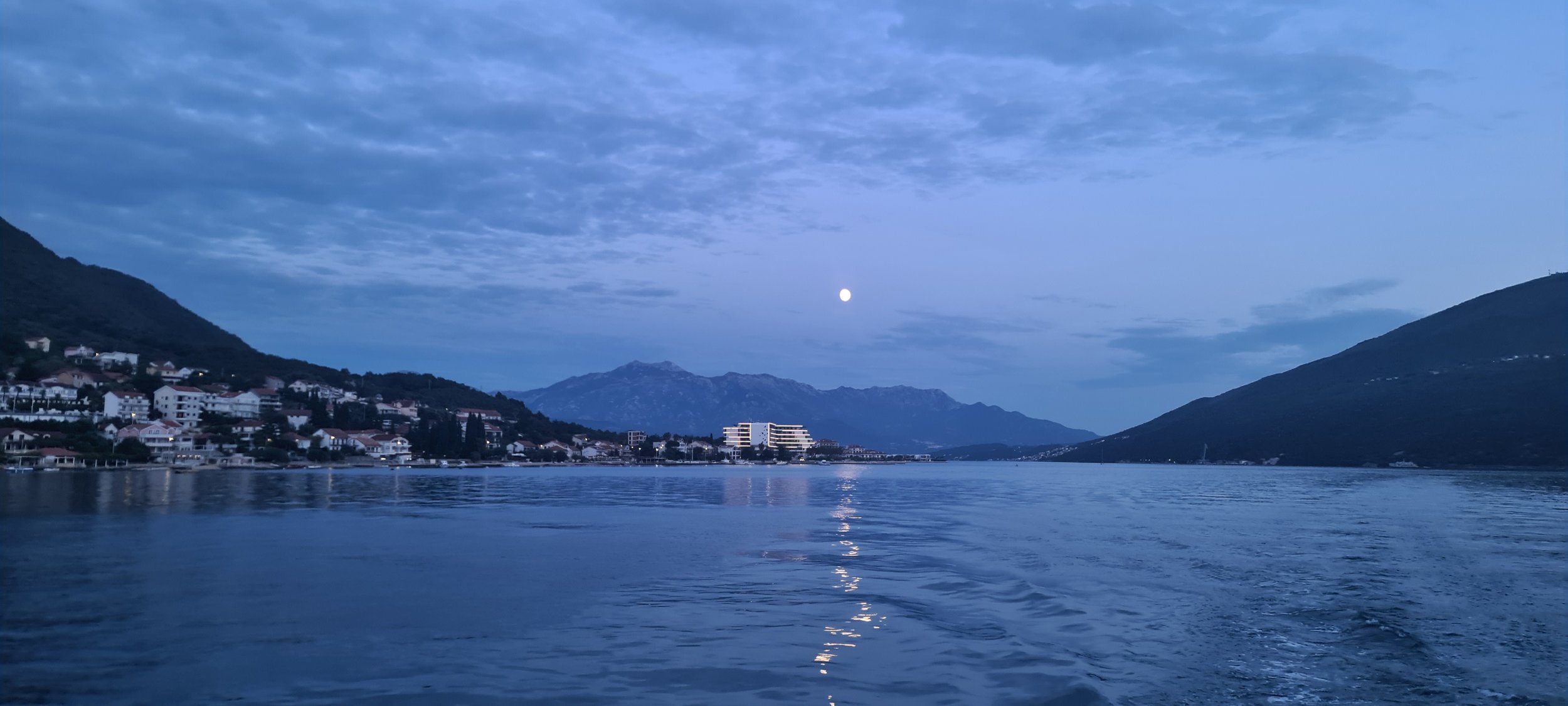Croatia & Montenegro – Southwards
It was a long ten hour day back to Stoja with a 15 minute stop at Porec to check into Croatia. Back to our familiar sandy anchorage, with great holding and good access to shore, although not sheltered from the southerly swell which made it very uncomfortable and difficult to tie the tender up. We discovered there was a bus service from Stoja to Pula (with a stop at the Max Mall) which was a lot easier than walking in humidity or tendering in rough seas but after several days of swell we decamped around to the main Pula Harbour, muddy with terrible holding but beautiful lit cranes at night. Having seen the colosseum, we wandered briefly through the old town, perusing bric-à-brac markets full of antiques and war memorabilia and explored the Zerostrasse – a network of underground WWI tunnels that could shelter 6,000 people, very cool in both senses of the word.
With new guests arriving in Zadar in three days’ time - schoolmates Kirsty, Fiona and goddaughter Katie, it was time to get underway and whereas we had taken six days coming up to Pula in early September, it actually was a very easy two, five hour days back down to Zadar. What was astounding was the number of boats we passed, at least 60+ and most of them chartered.
And then the fun began. So, so special to share NOETA with my mates of 49+ years and as you can imagine lots of laughter, card playing, singing, heartful chats and of course lashings of fine dining.
After a brief foray into old Zadar, we headed southwest to the Kornati archipelago, anchoring for the night in Otočić Krknata on the way; a quiet, sandy 10m anchorage, one of many in a lovely bay of islands. We had liked the look of Telašćica, a deep inleted wooded bay, it was green and serene, then the park rangers arrived for the HRK600 Telašćica fee. Having paid the rather expensive online three days Kornati National Park fee of HRK1200, we were slightly taken aback to discover that nearby Telašćica Nature Park was not covered. And not only that but the local restaurant was fully booked. Luckily there was one other - Konoba Krsovica; a 15 minute tender away, and it was perfect - simple fare and laughter on a chilly night.
The Kornati Park is literally metres away from Telašćica, but what a difference! A dry stark karst-limestone landscape with interesting circular geology and evidence of farming at some point, black fence lines on golden hills, a different sort of beauty. We had difficulty finding an anchorage as the wind was blowing from the west, however finally managed to find a spot between two scrubby islands; in retrospect we should have bought a one day ticket.
Planning on visiting the Krka National Park with its blue waterfalls, we then headed east back across to Sibenik. And what a delightful surprise entering the deceptively large harbour, 16th century St Nicholas guarding the entrance, past the cave of St Anthony and WWII tunnels. A grey day made more colourful by a wedding and children’s parade in the old town and 16th century St James cathedral with its 74 stone “portraits”. Legend has it they were either important people or didn’t contribute to the building, probably why some look attractive and others less so. And we were very impressed to see many divers cleaning up the harbour on a Saturday afternoon, especially because it was a sullen, cold day and the water was not at all inviting.
So still rainy and grey, amidst charter boats leaving on mass, we headed to the park - under the first bridge, (30m clearance) then an hour up a narrow winding channel lined with mussel and oyster farms and evidence of a massive fire, to a large shallow bay just before a second bridge. Deciding to anchor and tender the rest of the way up, it was a pleasant 45 minute trip up to Skradin and the entrance to Krka National Park, forested hills and the occasional shack. A large sign on the third bridge forbid further passage, so our options were to hike in or take a boat tour. The tour boats looked very full and we were COVID wary, there was nowhere to tie up in the ACI marina full of charter boats, we were getting tired of paying park fees, the sky was grey, and in that light it was debatable whether the falls would look blue - so decided to give the park a miss.
Back out and heading south to Rogoznica we were still amazed by the number of charter boats on the water, we hadn’t seen this many further south where it’s greener and even when it was the height of the season, why so many? Is the north more desirable, more accessible? Fortunately it didn’t really affect us, charterers seem to prefer to take a berth at a marina at the end of the day so we never had trouble securing quiet anchorages.
Trogir is much closer to Split airport than Split, so a perfect place to pick up Juliet on a flying visit from London, another 49+ years’ friend bringing us real bacon, pork sausages, homemade bolognaise and champagne - very spoilt. We could see a thunderstorm over Split so even more reason to stay west and anchor in a bay near Okrug Gornji marina; southwest of Trogir, the holding wasn’t great but it was easy for JD to get an Uber and the snorkelling was interestingly intense - fields of pen shells, sea cucumber and sea urchins.
The gals only had two days left, so we perused Trogir old town with its polished stone streets, narrow dark alleyways and seaside bric-à-brac markets before heading down to Hvar and main town Stari Grad, originally named Pharos by the Greek settlers from Paros in 384 BC. Another pretty little wooded bay and charming old stone village with a poet’s magical garden, local wine and Roman mosaics hidden under a concreted street. We caught up with Lady Roslyn and shared dinner at seaside Kodbarba Luka, expensive but at least the main square concert was free.
Back north, we anchored in six metres, muddy, on the east side of Trogir, which in retrospect would have been better than our anchorage on the west side at Okrug Gornji as it was much closer to town, although not as pretty. Two tender trips later ferrying our departing guests to shore, it was sad to say farewell.
Note: apparently you can also anchor just out from the airport and tie up near the runway; we weren’t game.
Then suddenly we were alone, on NOETA and on the sea, the further south we went, the fewer boats we saw, until there were none. We had had friends and some family staying for nigh on three months with the the occasional space of several days in between, it’s hard. Hard to say no and hard to keep your mojo; I did lose mine for a while, I think leaving Greece, missing family and getting burgled (twice) didn’t help.
Back to Brač with strong winds from the southeast we hugged the north coast for a couple of days and took shelter in Pučišća, waiting out the thunderstorms and heavy rain. Waking up to a beautiful morning we tendered around to the pretty little town, unique with its white limestone tiled roofed houses. The town is renowned for its limestone quarry, and local legend has it that Pučišća stone was used in the construction of the White House. Although it was a Sunday, the Stone Masonry School was open and young student Domagoy gave us a guided tour before he went back to work. Courses are three or four years and one of the impressive projects we saw was a large window rosette which was worth €120,000 – what happens if you make a mistake, I asked – you cry and start again, he replied.
Back down towards Korcula, along the mainland past Drasnice and Igrane, we saw many abandoned stone villages and the occasional minaret, reminding us of the terrible Yugoslav War that tore the country apart. It had been interesting talking to Croatians over the two months we had been there, some of the older generation spoke longingly of the Socialist time, when everyone had jobs and were given apartments to live in for life, whereas the younger generation did not want to to dwell in the past, they celebrated free enterprise and for them it was all about looking to the future, their Croatian future.
Anchoring just off the 14th century Franciscan Monastery on Badija, we noticed a bad vibration on the port side – a mass of fishing net and buoys around our prop, luckily no harm done (apart from losing antifouling on our rudder), we didn’t need any more prop drama. Also a large FKK sign, what did this mean, no anchoring? No apparently no nudity, which makes sense next to a monastery.
Deciding to investigate the bottom end of Mljet this time, we anchored in Luka Saplunara and enjoyed a culinary experience at the local MS restaurant - beautifully presented, it is tucked up a path in the trees, delicious food cooked by the unique chef/owner Mario. Unfortunately quite a few items, like the wild forest boar, were not available as they were two weeks away from season closure, and it was quite expensive - HRK1,800 for four people! We chose to think there may have been a mistake with the bill and we didn’t pick it up, damn, beware - but as we had caught up yet again with Lady Roslyn it was a great evening regardless.
Then Cavtat to check out and back down to Montenegro. How to sum up Croatia? It is one of six countries that were, until 1991, previously part of the Socialist Republic of Yugoslavia; before that part of the Austro-Hungarian empire, and before that the Republic of Venice. It is green and wooded, particularly in the south, with a long coastline and many islands in the Dalmatian region, further north towards Istria, it becomes drier and there is a much more pronounced Italian feel to it. There are eight National Parks and eleven Nature Parks, fields of sea cucumbers and charter boats. The Yugoslav war and preceding world wars are much in evidence with military buildings and tunnels lining the harbours and many sculptural monuments to fallen soldiers. I loved the antique markets and the red wine.
Montenegro in October, we sailed past Stradioti Island and anchored off Prevlaka Island, just out from the Tivat Airport Marina, which was perfect for our Volvo and genset service appointments with Yachting Services Markovic the next day, and also a close 5-10 minute tender to Tivat, where we could tie up in the tiny boat harbour and sneak around the small travelift to get into town. I had been feeling unwell most of the time in Croatia and still hadn’t come right so needed to find a GP. Nic had found and directed me to MANSA Medica, which, as it turned out, is a paediatric clinic, fortunately one of doctors recognised my inner child, was happy to see me and sort out my mojo issue. On the way I was tempted to start up a conversation with a chap operating his still in his backyard, but it was 1000, too early for me. A last provision at Voli, diesel tanks full, we checked out in Zelenika and then headed off into the full moon night across the Adriatic Sea, 100 nautical miles to Italy…
